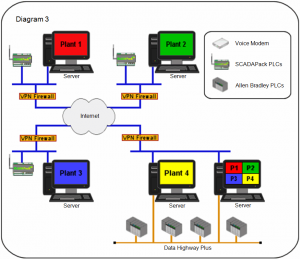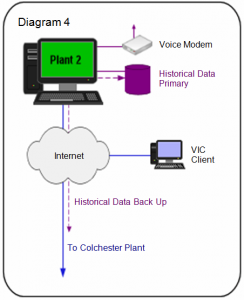Centralized Backup and Configuration for Remote Plant HMIs
As Wastewater Manager for four sewage treatment plants spread across Colchester County, Nova Scotia, Nicole MacDonald* faced the daunting task of ensuring all SCADA systems continued to function seamlessly on a 24/7 basis. Each plant had its own separate monitoring and control system that allowed it to function autonomously. What MacDonald really wanted was to be able to monitor all four plants and make configuration changes from her office. After reviewing her existing infrastructure, she saw the potential to transform these four systems into one unified solution that would also address long standing issues such as remote data backup and automatic system failover. Engineers from Trihedral Engineering Limited worked closely with MacDonald to bring her idea into reality.
History
Colchester County’s four treatment plants serviced approximately 45,000 residents. The Colchester plant (the largest in Atlantic Canada) was also home to Nicole MacDonald’s office and was the only plant with full time staff.
Monitoring at the Colchester plant was handled by RS View HMI software running on four PCs connected to four Allen Bradley PLCs via a Data Highway Plus (DH+) network (Diagram 1). An alarm dialer notified staff in the event of increased or decreased flow, gas or fire.
The Tatamagouche, Great Village, and Brookfield plants all used identical systems consisting of a SCADAPack PLC from Control Microsystems and a VTScada Alarm Dialer connected to a PC running VTScada HMI software from Trihedral Engineering. (Diagram 2)
Despite the sophistication of these systems, several issues remained.
- Plants could not be monitored from one central location
- Configuration changes had to be done on-site at each plant
- There was no remote backup of each plant’s historical data
- Two kinds of HMI meant more training and a steeper learning curve for employees
- All Colchester servers communicated with local PLCs simultaneously, resulting in unnecessary network traffic
Design
To address the first issue, it was decided that all four plants would use the same HMI software. Since VTScada was already being used in three of the plants, the Colchester plant would be switched over to use VTScada as well.
During initial discussions with Trihedral, MacDonald proposed that they use the opportunity to go even further. She wanted to create a single unified system that addressed all her long-standing concerns about historical data backup and automatic system failover.
Trihedral developer Doug Spurrell worked closely with MacDonald to create an elegant design that made the best use of the infrastructure they already had. “Since so much of what we were doing was about remote monitoring and control, it was also very important to us to increase the security for the whole system,” said Spurrell.
“The people at Trihedral were great to work with,” remembered MacDonald. “I always knew I could reach them if I needed to speak with them.”
A Unified Design
Each of the four plants now runs a primary HMI server which communicates with local I/O via its own Local Area Network (LAN) and maintains a database of local historical data. (Diagram 3)
Additionally, each plant’s HMI can be viewed remotely via Internet client and has a VTScada Alarm Dialer that communicates alarm information to operations personnel. Moreover, alarms for all of the plants can be viewed and acknowledged from a single computer in the Colchester office.
Benefits
- Centralized monitoring and control: To meet MacDonald’s central computer requirements, a workstation, located in the Colchester plant, is connected to each of the other three plants via high speed Internet.
- Security: Each connection is secured by an inexpensive VPN firewall device.
- Remote configuration: Over these remote connections MacDonald can simultaneously monitor and make remote, online configuration changes without leaving her office or restarting the on-site primary servers. “The old system was just something visual that I could only look at.” says MacDonald, “Now if there are conditions that make it dangerous or impossible to reach the plants, we can make configuration changes from almost anywhere.”
- Remote back up: All four historical databases are replicated on the central workstation in Colchester, providing convenient, offsite database backups. (Diagram 4)
- Remote failover: By connecting the PLCs at each plant to their own Local Area Networks, MacDonald’s workstation can now take over all server functionality, including I/O communications, for any or all of the plants in the event their (on-site) primary servers fail.
- Reduced learning Curve: Adopting a unified SCADA methodology was not the only way that MacDonald and Spurrell were able to help Colchester personnel. Spurrell recalls, “I started with the HMI application that they had been using at Colchester and I made sure that the screens for the VTScada application had the same look and feel. At the same time Spurrell improved workflow by drastically reducing the number of screens and grouping together related data. “This system is a lot easier to use.” says MacDonald.
- Overlapping trend data
 : The integrated VTScada Historical Data Viewer allows users to discover patterns and problems in their process. For example, if a pump stops because of a power blip it can result in mysterious readings across the system. By overlaying pump rates over a flow curve in the VTScada Historical Data Viewer, users can trace anomalous readings back to their original source. In this case, the stopped pump. “Then, once I’ve found the problem, I can write a note on the trend itself for future reference.” says MacDonald.
: The integrated VTScada Historical Data Viewer allows users to discover patterns and problems in their process. For example, if a pump stops because of a power blip it can result in mysterious readings across the system. By overlaying pump rates over a flow curve in the VTScada Historical Data Viewer, users can trace anomalous readings back to their original source. In this case, the stopped pump. “Then, once I’ve found the problem, I can write a note on the trend itself for future reference.” says MacDonald. - Integrated Logbook: Previously, Colchester staff hand wrote comments like these into log books. VTScada improves on this process by providing an electronic operator’s notes display. User notes are automatically time-stamped and labeled with the operator’s name. Once created, notes cannot be edited and the entire log is saved to an encrypted file that is unreadable outside VTScada. MacDonald much prefers this electronic approach, “It gives me something neater to work with so I’m not trying to read people’s writing. That saves a lot of time.”
- More historical data: The new system is able to handle much more data. “Before we could only record twenty-four hours worth of trend information. Now we can go back several years.”
- Application Development: A development license allows MacDonald to make configuration changes herself at the Colchester plant.
Continuing Expansion
Based on the outstanding performance of the VTScada system, in 2013, the Municipality of Colchester decided to replace the existing Wonderware InTouch™ application at a separate water treatment plant in nearby Debert. The two-week development process involved converting the existing 300 tag database and rebuilding the six operator displays using built-in high-resolution graphics. There are immediate plans to link this new system into the existing VTScada application.
| Try It For Yourself Download the 90-day Trial |
Download the Article as PDF |
Images used with permission.
*Nicole MacDonald has since left her position with the County
